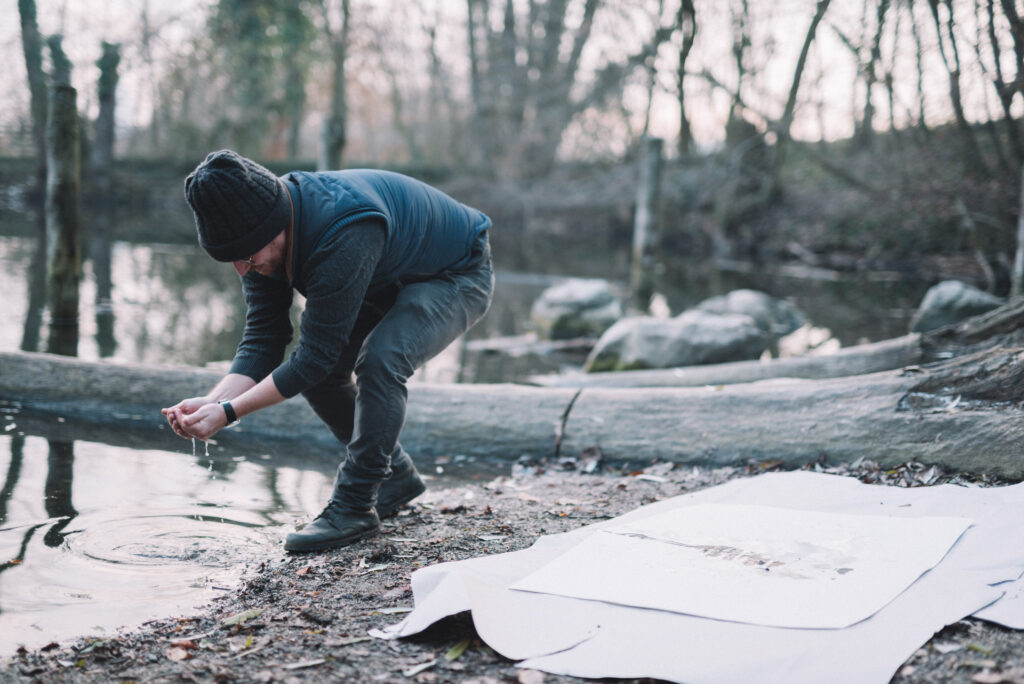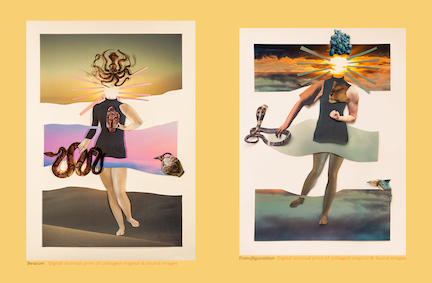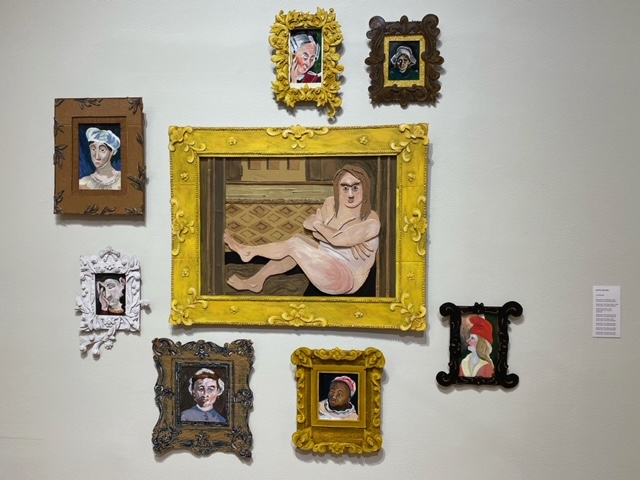The 2022 Mills MFA show opened with a bang on April 30, with a reception and an evening of art-viewing for many a wide-eyed visitor to the Mills Art Museum. Among the artists featured in the exhibit are Mittie Cuetara, Markus Kager and Shelley Carlisle.
For many MFA students, Mills offers the opportunity to work in close proximity to other artists and learn from each other by creative osmosis. Cuetara, who hails from Boston, found her people within the Mills MFA program.
“When I moved to California, I didn’t realize that I would be sort of leaving my whole community behind,” she reflects.
A sense of community has been central to her art-making successes.
“I’ve loved being with other artists and sharing ideas and conversations. It’s really affected my work a lot, I think because I was out of school for a while and I got kind of insular,” she explains. “To keep making stuff that’s connected to the world, you need to be connected to the world.”
Cuetara’s work features themes of feminism and domesticity, which derive from her long-time frustration with the lack of adequate female representation in the classical art world.
“I’ve always had issues with the way women are represented [in classical art] and the history of women in art. There were all these women [in famous paintings] that were just bystanders, in the corners, as filler, and I wanted to make those women have their own paintings,” she says of the laborers, waitresses and maids on whom she shines the spotlight.
“That inspired me to make these beautiful cardboard frames for them, super fancy, kind of faux fancy,” she explains. “It was like, here you are. Here’s your place in history.”
For Cuetara, art-making is expansive by definition, and she embraces the breadth of the term and the room it leaves for artists of all types.
“I feel there needs to be room for all different kinds of art and artists,” she explains. “I mean, even if you’re just finger painting in your room, you’re an artist, you know? Part of me wants to go, oh, I should be more like [other artists]. But the upshot is that I shouldn’t. I should be more like me.”
The realm of the domestic captivates Cuetara, who renders intimate scenes in three-dimensional paintings that jut off the canvases.
“When I make pieces about domestic scenes, I think I am saying, this stuff is beautiful and interesting and fabulous. And just as interesting as Mount Rushmore, to me.”
Making art is necessarily a process of transience and change, and Cuetara is learning to embrace the uncertainty that comes with consistent creation.
“As an artist, I feel that you have to be able to have uncertainty. So I’m trying to let myself be uncertain. I’m working on building that muscle. Because if you want to do something new, you have to allow a certain amount of uncertainty,” she says.
Similarly, tuning in to the variance and uncertainty around him is what Markus Kager focuses on in his work.
“It’s about capturing dynamics of the atmosphere and the environment,” Kager explains. “And it’s very site specific.”
Originally from Austria, Kager has embraced the geologic uncertainties of the Bay Area and used them as inspiration for his dreamy ink-on-paper creations.
“I use a stack of paper and ink,” he says. “The paper [serves as] a structure in space and time and the ink can flow with time. I go outside to specific places and environments and I set everything up and let the ink react to the environment.”
Kager’s practice creates unique records, often taking multiple days to produce, of a natural world that is subject to change and even danger.
“Living in the Bay Area, everything is so fragile, and everything moves. When the earth is shaking, it’s a reminder of how small you are. It’s existential,” he says. “Living in the center of Europe feels very stable and there is not really a lot of concern about nature.”
Kager emphasizes the need to redefine our relationship with nature and humble ourselves in its presence.
“If you’re not reminded [of nature] you can put yourself in a kind of superposition because you become so important,” he says. “And you don’t wonder about the stars, the moon, the sun, and all of these dynamics anymore because you’re not present.”
By reviving a sense of presence and reverence, Kager explores the relationships between humans and the environment.
“It’s about discovering the interplay between the wind, gravity, and biological entities. And how the human species is entangled with nature,” he says. “For me, it’s a form of re-establishing a relationship to planet earth.”
Carlisle, too, is captivated by natural phenomena, and she puts her own unique spin on the historical and the natural in her work. After beginning as a painter and illustrator, Carlisle transitioned to photography, collage, and video installations.
“I’ve always been passionate about documenting the landscape and my travels,” she says. “So I’ve expanded upon that. I started doing landscape photography. And then I was doing a little bit of wildlife photography. And I’m taking those images and cutting them up and putting them into collages.”
Carlisle’s life-sized collages combine found images with those she has created herself. A central theme in her work is the sacred feminine, a metaphorical figure that has been demonized throughout time and which she brings back to life in her compilations.
“I’m using symbols and imagery from the Ancient Minoan Greek Culture from Crete,” she says. “My thinking is that patriarchy has demolished the sacred feminine and the earth and there’s all this destruction and lack of balanced stewardship of our resources. And if we could have the sacred feminine back and balance, we could better manage our planet.”
Carlisle combines her past experiences with graphic design and jazz vocal performance with her visual art, creating multimedia experiences that entice viewers with their variety.
About the future, Carlisle says, “I’m creating it. So that’s exciting, and really scary. At this stage in life, I feel confident that I can create something. I’ve done a lot of different things, so I feel confident that I’ll put it together.”
Students and guests can view the exhibition at the Mills Art Museum until May 29.



